Bencheng Liao
Seed1.5-VL Technical Report
May 11, 2025Abstract:We present Seed1.5-VL, a vision-language foundation model designed to advance general-purpose multimodal understanding and reasoning. Seed1.5-VL is composed with a 532M-parameter vision encoder and a Mixture-of-Experts (MoE) LLM of 20B active parameters. Despite its relatively compact architecture, it delivers strong performance across a wide spectrum of public VLM benchmarks and internal evaluation suites, achieving the state-of-the-art performance on 38 out of 60 public benchmarks. Moreover, in agent-centric tasks such as GUI control and gameplay, Seed1.5-VL outperforms leading multimodal systems, including OpenAI CUA and Claude 3.7. Beyond visual and video understanding, it also demonstrates strong reasoning abilities, making it particularly effective for multimodal reasoning challenges such as visual puzzles. We believe these capabilities will empower broader applications across diverse tasks. In this report, we mainly provide a comprehensive review of our experiences in building Seed1.5-VL across model design, data construction, and training at various stages, hoping that this report can inspire further research. Seed1.5-VL is now accessible at https://www.volcengine.com/ (Volcano Engine Model ID: doubao-1-5-thinking-vision-pro-250428)
MaTVLM: Hybrid Mamba-Transformer for Efficient Vision-Language Modeling
Mar 17, 2025Abstract:With the advancement of RNN models with linear complexity, the quadratic complexity challenge of transformers has the potential to be overcome. Notably, the emerging Mamba-2 has demonstrated competitive performance, bridging the gap between RNN models and transformers. However, due to sequential processing and vanishing gradients, RNN models struggle to capture long-range dependencies, limiting contextual understanding. This results in slow convergence, high resource demands, and poor performance on downstream understanding and complex reasoning tasks. In this work, we present a hybrid model MaTVLM by substituting a portion of the transformer decoder layers in a pre-trained VLM with Mamba-2 layers. Leveraging the inherent relationship between attention and Mamba-2, we initialize Mamba-2 with corresponding attention weights to accelerate convergence. Subsequently, we employ a single-stage distillation process, using the pre-trained VLM as the teacher model to transfer knowledge to the MaTVLM, further enhancing convergence speed and performance. Furthermore, we investigate the impact of differential distillation loss within our training framework. We evaluate the MaTVLM on multiple benchmarks, demonstrating competitive performance against the teacher model and existing VLMs while surpassing both Mamba-based VLMs and models of comparable parameter scales. Remarkably, the MaTVLM achieves up to 3.6x faster inference than the teacher model while reducing GPU memory consumption by 27.5%, all without compromising performance. Code and models are released at http://github.com/hustvl/MaTVLM.
OmniMamba: Efficient and Unified Multimodal Understanding and Generation via State Space Models
Mar 11, 2025Abstract:Recent advancements in unified multimodal understanding and visual generation (or multimodal generation) models have been hindered by their quadratic computational complexity and dependence on large-scale training data. We present OmniMamba, the first linear-architecture-based multimodal generation model that generates both text and images through a unified next-token prediction paradigm. The model fully leverages Mamba-2's high computational and memory efficiency, extending its capabilities from text generation to multimodal generation. To address the data inefficiency of existing unified models, we propose two key innovations: (1) decoupled vocabularies to guide modality-specific generation, and (2) task-specific LoRA for parameter-efficient adaptation. Furthermore, we introduce a decoupled two-stage training strategy to mitigate data imbalance between two tasks. Equipped with these techniques, OmniMamba achieves competitive performance with JanusFlow while surpassing Show-o across benchmarks, despite being trained on merely 2M image-text pairs, which is 1,000 times fewer than Show-o. Notably, OmniMamba stands out with outstanding inference efficiency, achieving up to a 119.2 times speedup and 63% GPU memory reduction for long-sequence generation compared to Transformer-based counterparts. Code and models are released at https://github.com/hustvl/OmniMamba
Multimodal Mamba: Decoder-only Multimodal State Space Model via Quadratic to Linear Distillation
Feb 18, 2025Abstract:Recent Multimodal Large Language Models (MLLMs) have achieved remarkable performance but face deployment challenges due to their quadratic computational complexity, growing Key-Value cache requirements, and reliance on separate vision encoders. We propose mmMamba, a framework for developing linear-complexity native multimodal state space models through progressive distillation from existing MLLMs using moderate academic computational resources. Our approach enables the direct conversion of trained decoder-only MLLMs to linear-complexity architectures without requiring pre-trained RNN-based LLM or vision encoders. We propose an seeding strategy to carve Mamba from trained Transformer and a three-stage distillation recipe, which can effectively transfer the knowledge from Transformer to Mamba while preserving multimodal capabilities. Our method also supports flexible hybrid architectures that combine Transformer and Mamba layers for customizable efficiency-performance trade-offs. Distilled from the Transformer-based decoder-only HoVLE, mmMamba-linear achieves competitive performance against existing linear and quadratic-complexity VLMs, while mmMamba-hybrid further improves performance significantly, approaching HoVLE's capabilities. At 103K tokens, mmMamba-linear demonstrates 20.6$\times$ speedup and 75.8% GPU memory reduction compared to HoVLE, while mmMamba-hybrid achieves 13.5$\times$ speedup and 60.2% memory savings. Code and models are released at https://github.com/hustvl/mmMamba
RAD: Training an End-to-End Driving Policy via Large-Scale 3DGS-based Reinforcement Learning
Feb 18, 2025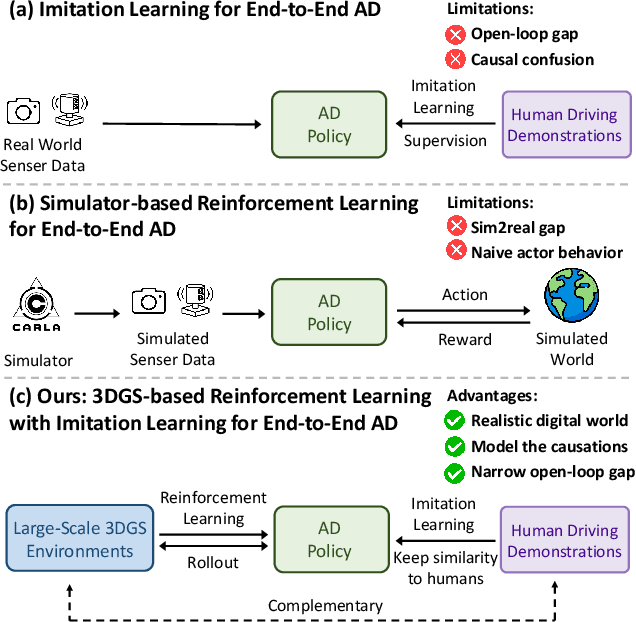

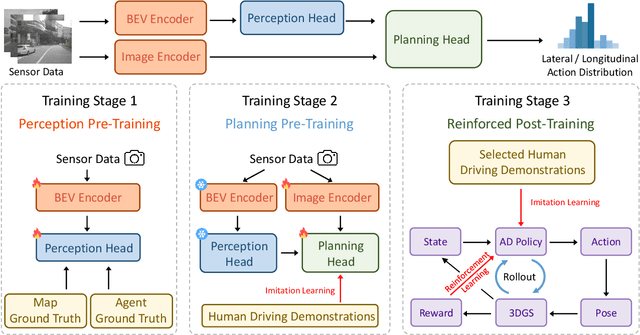

Abstract:Existing end-to-end autonomous driving (AD) algorithms typically follow the Imitation Learning (IL) paradigm, which faces challenges such as causal confusion and the open-loop gap. In this work, we establish a 3DGS-based closed-loop Reinforcement Learning (RL) training paradigm. By leveraging 3DGS techniques, we construct a photorealistic digital replica of the real physical world, enabling the AD policy to extensively explore the state space and learn to handle out-of-distribution scenarios through large-scale trial and error. To enhance safety, we design specialized rewards that guide the policy to effectively respond to safety-critical events and understand real-world causal relationships. For better alignment with human driving behavior, IL is incorporated into RL training as a regularization term. We introduce a closed-loop evaluation benchmark consisting of diverse, previously unseen 3DGS environments. Compared to IL-based methods, RAD achieves stronger performance in most closed-loop metrics, especially 3x lower collision rate. Abundant closed-loop results are presented at https://hgao-cv.github.io/RAD.
DiffusionDrive: Truncated Diffusion Model for End-to-End Autonomous Driving
Nov 22, 2024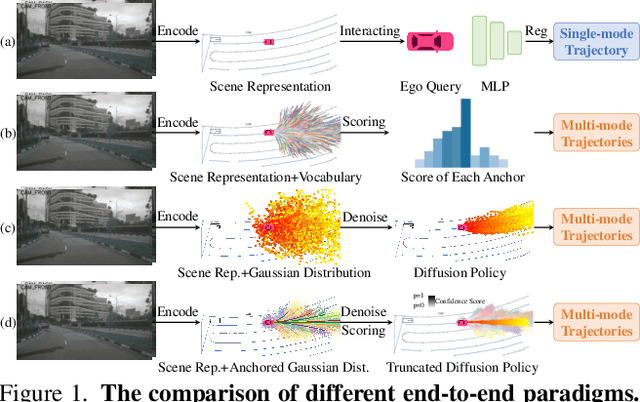

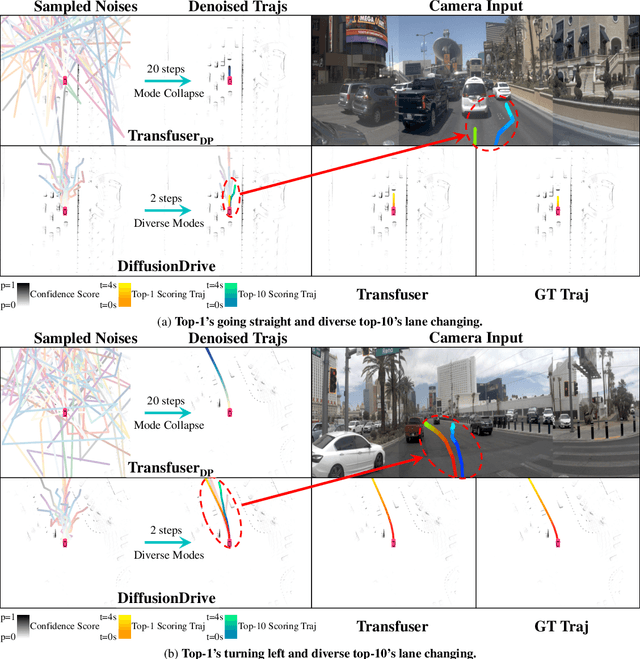

Abstract:Recently, the diffusion model has emerged as a powerful generative technique for robotic policy learning, capable of modeling multi-mode action distributions. Leveraging its capability for end-to-end autonomous driving is a promising direction. However, the numerous denoising steps in the robotic diffusion policy and the more dynamic, open-world nature of traffic scenes pose substantial challenges for generating diverse driving actions at a real-time speed. To address these challenges, we propose a novel truncated diffusion policy that incorporates prior multi-mode anchors and truncates the diffusion schedule, enabling the model to learn denoising from anchored Gaussian distribution to the multi-mode driving action distribution. Additionally, we design an efficient cascade diffusion decoder for enhanced interaction with conditional scene context. The proposed model, DiffusionDrive, demonstrates 10$\times$ reduction in denoising steps compared to vanilla diffusion policy, delivering superior diversity and quality in just 2 steps. On the planning-oriented NAVSIM dataset, with the aligned ResNet-34 backbone, DiffusionDrive achieves 88.1 PDMS without bells and whistles, setting a new record, while running at a real-time speed of 45 FPS on an NVIDIA 4090. Qualitative results on challenging scenarios further confirm that DiffusionDrive can robustly generate diverse plausible driving actions. Code and model will be available at https://github.com/hustvl/DiffusionDrive.
Senna: Bridging Large Vision-Language Models and End-to-End Autonomous Driving
Oct 29, 2024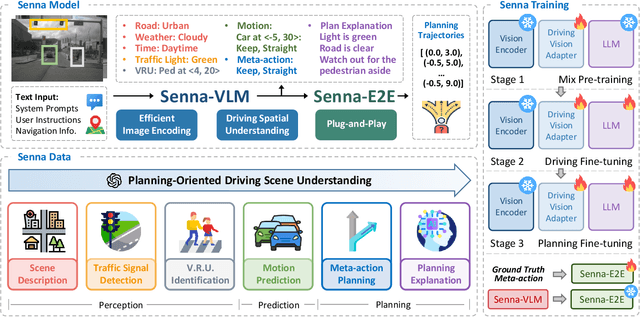
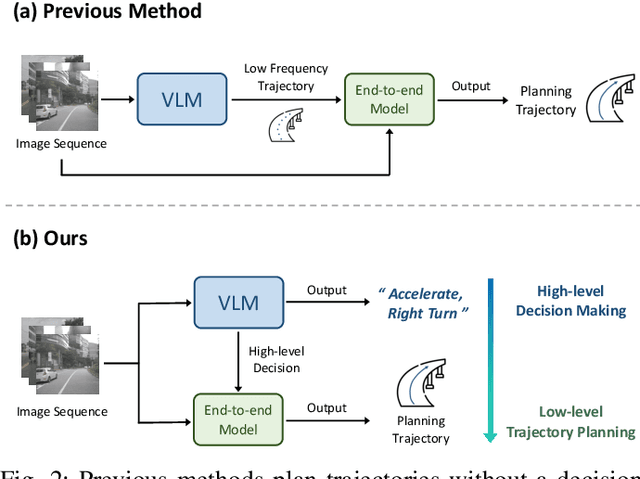
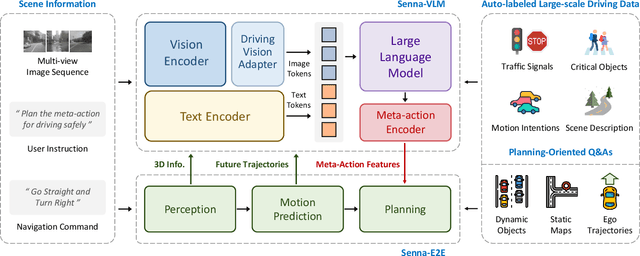

Abstract:End-to-end autonomous driving demonstrates strong planning capabilities with large-scale data but still struggles in complex, rare scenarios due to limited commonsense. In contrast, Large Vision-Language Models (LVLMs) excel in scene understanding and reasoning. The path forward lies in merging the strengths of both approaches. Previous methods using LVLMs to predict trajectories or control signals yield suboptimal results, as LVLMs are not well-suited for precise numerical predictions. This paper presents Senna, an autonomous driving system combining an LVLM (Senna-VLM) with an end-to-end model (Senna-E2E). Senna decouples high-level planning from low-level trajectory prediction. Senna-VLM generates planning decisions in natural language, while Senna-E2E predicts precise trajectories. Senna-VLM utilizes a multi-image encoding approach and multi-view prompts for efficient scene understanding. Besides, we introduce planning-oriented QAs alongside a three-stage training strategy, which enhances Senna-VLM's planning performance while preserving commonsense. Extensive experiments on two datasets show that Senna achieves state-of-the-art planning performance. Notably, with pre-training on a large-scale dataset DriveX and fine-tuning on nuScenes, Senna significantly reduces average planning error by 27.12% and collision rate by 33.33% over model without pre-training. We believe Senna's cross-scenario generalization and transferability are essential for achieving fully autonomous driving. Code and models will be released at https://github.com/hustvl/Senna.
ViG: Linear-complexity Visual Sequence Learning with Gated Linear Attention
May 29, 2024Abstract:Recently, linear complexity sequence modeling networks have achieved modeling capabilities similar to Vision Transformers on a variety of computer vision tasks, while using fewer FLOPs and less memory. However, their advantage in terms of actual runtime speed is not significant. To address this issue, we introduce Gated Linear Attention (GLA) for vision, leveraging its superior hardware-awareness and efficiency. We propose direction-wise gating to capture 1D global context through bidirectional modeling and a 2D gating locality injection to adaptively inject 2D local details into 1D global context. Our hardware-aware implementation further merges forward and backward scanning into a single kernel, enhancing parallelism and reducing memory cost and latency. The proposed model, ViG, offers a favorable trade-off in accuracy, parameters, and FLOPs on ImageNet and downstream tasks, outperforming popular Transformer and CNN-based models. Notably, ViG-S matches DeiT-B's accuracy while using only 27% of the parameters and 20% of the FLOPs, running 2$\times$ faster on $224\times224$ images. At $1024\times1024$ resolution, ViG-T uses 5.2$\times$ fewer FLOPs, saves 90% GPU memory, runs 4.8$\times$ faster, and achieves 20.7% higher top-1 accuracy than DeiT-T. These results position ViG as an efficient and scalable solution for visual representation learning. Code is available at \url{https://github.com/hustvl/ViG}.
DiG: Scalable and Efficient Diffusion Models with Gated Linear Attention
May 28, 2024



Abstract:Diffusion models with large-scale pre-training have achieved significant success in the field of visual content generation, particularly exemplified by Diffusion Transformers (DiT). However, DiT models have faced challenges with scalability and quadratic complexity efficiency. In this paper, we aim to leverage the long sequence modeling capability of Gated Linear Attention (GLA) Transformers, expanding its applicability to diffusion models. We introduce Diffusion Gated Linear Attention Transformers (DiG), a simple, adoptable solution with minimal parameter overhead, following the DiT design, but offering superior efficiency and effectiveness. In addition to better performance than DiT, DiG-S/2 exhibits $2.5\times$ higher training speed than DiT-S/2 and saves $75.7\%$ GPU memory at a resolution of $1792 \times 1792$. Moreover, we analyze the scalability of DiG across a variety of computational complexity. DiG models, with increased depth/width or augmentation of input tokens, consistently exhibit decreasing FID. We further compare DiG with other subquadratic-time diffusion models. With the same model size, DiG-XL/2 is $4.2\times$ faster than the recent Mamba-based diffusion model at a $1024$ resolution, and is $1.8\times$ faster than DiT with CUDA-optimized FlashAttention-2 under the $2048$ resolution. All these results demonstrate its superior efficiency among the latest diffusion models. Code is released at https://github.com/hustvl/DiG.
MIM4D: Masked Modeling with Multi-View Video for Autonomous Driving Representation Learning
Mar 13, 2024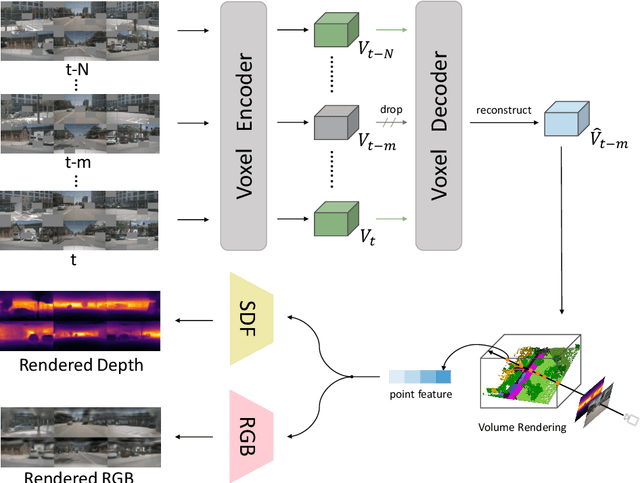



Abstract:Learning robust and scalable visual representations from massive multi-view video data remains a challenge in computer vision and autonomous driving. Existing pre-training methods either rely on expensive supervised learning with 3D annotations, limiting the scalability, or focus on single-frame or monocular inputs, neglecting the temporal information. We propose MIM4D, a novel pre-training paradigm based on dual masked image modeling (MIM). MIM4D leverages both spatial and temporal relations by training on masked multi-view video inputs. It constructs pseudo-3D features using continuous scene flow and projects them onto 2D plane for supervision. To address the lack of dense 3D supervision, MIM4D reconstruct pixels by employing 3D volumetric differentiable rendering to learn geometric representations. We demonstrate that MIM4D achieves state-of-the-art performance on the nuScenes dataset for visual representation learning in autonomous driving. It significantly improves existing methods on multiple downstream tasks, including BEV segmentation (8.7% IoU), 3D object detection (3.5% mAP), and HD map construction (1.4% mAP). Our work offers a new choice for learning representation at scale in autonomous driving. Code and models are released at https://github.com/hustvl/MIM4D
 Add to Chrome
Add to Chrome Add to Firefox
Add to Firefox Add to Edge
Add to Edge